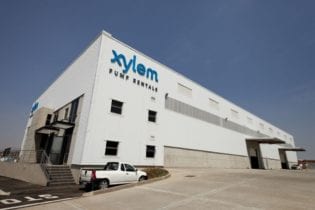Engineers and investors alike are increasing their risk margins to incorporate the risk of climate change, where the potential change in rainfall patterns and events could be more threatening to project viability and sustainability.
Mine water balance by Peter Shepherd* As part of a pre-feasibility study for a mine (new mine or an existing mine that is being expanded) there is a risk portion included in the capital portion of the feasibility study to encompass areas that may need additional capital. Typical capital risk portions in a prefeasibility study could be the inclusion of a liner under a tailings dam because of the unknown potential for seepage under the tailings dam. All aspects of planning and implementation must be taken into account when assessing the financial risk faced by any new mining operation or expansion project, and climate change has definitely been introducing more uncertainty into future scenarios for these projects. In South Africa, for instance, climate change could make the eastern parts of the country significantly wetter and western regions drier, according to studies by researchers TG Lumsden and RE Shulze. They predict that in the eastern areas of the country, mines will experience a disproportionate increase in the amount of water that is spilled into the environment. On the other hand, mines in the western parts will need to manage their water supply with greater care. Using the Lumsden and Shulze research, SRK scientists, Phillip Hull and Hediyih Ghassai, predicted that a 40% increase in rainfall could more than double the amount of contaminated water spilled by a mine into the environment. The risk of spillage is directly related to the rainfall expectations for a particular area – and not just the amount of rain but also the way in which the rain falls. Looking into the future, we are anticipating that the intensity of precipitation in a particular area could be more intense meaning that the same amount of rainfall could fall in a much shorter period. This has implications for the amount of run-off that a mine site will need to deal with and could mean that additional storm water controls that are much bigger than under present conditions, will need to be constructed and additional equipment may be needed to manage the silt that flows from the mine site. Baseline Greenfield projects need data to be gathered over the entire year to incorporate the dry and wet seasons, combined with historical rainfall data, to establish a baseline for how water issues are best incorporated into the design of a new operation. Monitoring systems are put in place to gather primary data over a 12-month period on precipitation, run-off and water quality. The historical data from the various government departments are also collected but usually these records from national water authorities are collected on a regional scale and the local site hydrology and meteology data needs to be collected at the site. This baseline gives engineers the parameters in which to optimise their designs, and make cost-effective proposals to clients about how to manage the various elements of risk. The data collection is relatively small from a hydrological perspective. Clearly, a baseline cannot give a risk-free prediction for what conditions need to be accommodated by site infrastructure; so a risk margin is then built into the future scenarios that need to be considered. A risk workshop – held with the client – is a good forum for considering the cost implications of the various risk scenarios, and for deciding on strategies that are cost-effective while adequately mitigating against any mission-critical failures. The new unknown This is where climate change has emerged as a factor that consulting engineers need to flag to clients as a further uncertainty. Given the evidence of changing weather patterns in various parts of the world, we can no longer assume that our baseline reflects a static picture that can be relied upon in the short-to medium-term future. So we need to ask questions like: – What if rainfall intensity increases how much bigger will we need to build our storm water controls?– What if rainfall increases how much bigger will we need to build our dirty water containment facilities?
– Will the yield from our water storage facilities still be sufficient to adequately supply the mine with water if there is a significantly drier period of rainfall than the historical dataset? – Will an increase in rainfall increase the excess water that the mines will need to deal with? The risks posed by these uncertainties might be operational, environmental or reputational, but they all affect the sustainability of the operation and therefore need careful consideration in advance of final design and implementation decisions. At an operational level, a relatively small shift in the intensity and length of a downpour could lead to the flooding of an open pit, leading to cessation of mining operations and possible damage to in-pit facilities. If such a precipitation event can be built into the risk profile, however, then the appropriate design could accommodate this. A relatively simple up-front design solution such as increased pipe diameter and pump capacity could be proposed with only minor impact on the capital expenditure incurred. The solution, even if more expensive, would certainly be substantially less costly than trying to introduce these specifications on an already-operating site experiencing extraordinary precipitation levels. Regulating impact There is hardly a country that has not tightened up its environmental laws in recent years, and mines have in many instances been pioneers in mitigating and avoiding environmental impact. The area remains a significant risk for developers and managers, however, especially as climate change threatens to ‘move the goalposts’. In areas that are likely to experience less rainfall going forward, better re-use strategies will be required to manage the on-mine water balance. Continued improvement is required in the design and implementation of ways to keep dirty water within the mine boundary, and to limit the amount of clean water that mines procure from municipal or other sources. In South Africa, the Water Act of 1998 has also forced mines to focus on floodlines on or near their properties; in the context of climate change, mines also need to pro-actively anticipate more frequent flood occurrences – which may even exceed previous record levels. In areas where more rain is predicted, mines face the prospect of breaking the law if their infrastructure is not able to limit mine spillage into the environment surrounding the site. Facilities in these areas must be designed or modified to account for the new parameters that climate change brings. For instance, if a tailings dam is designed for a one-in-50-year storm event, and changing climatic conditions reduces this probability to one-in-20-years, then this can pose a severe threat to the downstream environment. Reputational risk Any negative impact on surrounding communities is a risk to the reputation of the owners and financiers of a project. Even in terms of most national laws, mines’ storm water control strategies must also address the safety of others – such as surrounding communities or downstream areas. Flooding of Return Water Dams is a particular risk in this regard; here in South Africa, it is strictly enforced by the Department of Water Affairs Dam Safety Office. A new dam safety regulation has been promulgated in South Africa that now requires dams to be classified in terms of the size as well as its hazard potential. From a mining perspective all polluted water dams will need to apply for the services of an Approved Professional Person to do the design as well as apply for a licence. Many of the documents that the regulation requires are being prepared by the mines such as design reports (details of dam, hydrology, structural, hydraulic components) plus a flood handling procedure, engineering drawings (locality, layout sections) and dam safety aspects (if inundation of development may occur). The impact of hydrology on the dams is an important aspect for the design of these dams. Increased daytime temperatures associated with climate change also bring their own risks to the efficient running of a mine and its plant. Where temperatures rise just a degree, the effect on evaporation levels from on-site water storage facilities could be much higher. As mines pursue water-conserving technologies that rely on re-use of stored water, there may be a higher risk of treatment plants having to deal with more polluted water due to the evaporation increasing the salinity in the water. So the overall impact of climate change on the water risks associated with greenfields and brown fields mining projects is undoubtedly adding more risk – and hence more cost – to the planning and building of new mines and their infrastructure. This is bound to be the case as greater uncertainty is introduced into the engineering and financial equations underlying any sustainable project. But equally, the science behind climate change is improving continuously as we make more detailed studies of shifting weather patterns and their impacts around the world. These are all feeding into a growing body of knowledge that will gradually erode some of the uncertainties we currently face in the management of projects’ water risk. The data, of course, will still need to be modelled for the purposes of prediction, and there will always be a variety of modelling methodologies and results to be considered. But the joint endeavours of on-site professionals, contracted consulting engineers, researchers, academics and other stakeholders will keep us at the cutting edge of technologies to manage water in ways that our enterprises and our environment demand.




